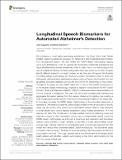Longitudinal Speech Biomarkers for Automated Alzheimer's Detection
Author(s)
Laguarta Soler, Jordi; Subirana-Vilanova, J. Brian
Downloadfcomp-03-624694.pdf (1.771Mb)
Publisher with Creative Commons License
Publisher with Creative Commons License
Creative Commons Attribution
Terms of use
Metadata
Show full item recordAbstract
We introduce a novel audio processing architecture, the Open Voice Brain Model (OVBM), improving detection accuracy for Alzheimer's (AD) longitudinal discrimination from spontaneous speech. We also outline the OVBM design methodology leading us to such architecture, which in general can incorporate multimodal biomarkers and target simultaneously several diseases and other AI tasks. Key in our methodology is the use of multiple biomarkers complementing each other, and when two of them uniquely identify different subjects in a target disease we say they are orthogonal. We illustrate the OBVM design methodology by introducing sixteen biomarkers, three of which are orthogonal, demonstrating simultaneous above state-of-the-art discrimination for two apparently unrelated diseases such as AD and COVID-19. Depending on the context, throughout the paper we use OVBM indistinctly to refer to the specific architecture or to the broader design methodology. Inspired by research conducted at the MIT Center for Brain Minds and Machines (CBMM), OVBM combines biomarker implementations of the four modules of intelligence: The brain OS chunks and overlaps audio samples and aggregates biomarker features from the sensory stream and cognitive core creating a multi-modal graph neural network of symbolic compositional models for the target task. In this paper we apply the OVBM design methodology to the automated diagnostic of Alzheimer's Dementia (AD) patients, achieving above state-of-the-art accuracy of 93.8% using only raw audio, while extracting a personalized subject saliency map designed to longitudinally track relative disease progression using multiple biomarkers, 16 in the reported AD task. The ultimate aim is to help medical practice by detecting onset and treatment impact so that intervention options can be longitudinally tested. Using the OBVM design methodology, we introduce a novel lung and respiratory tract biomarker created using 200,000+ cough samples to pre-train a model discriminating cough cultural origin. Transfer Learning is subsequently used to incorporate features from this model into various other biomarker-based OVBM architectures. This biomarker yields consistent improvements in AD detection in all the starting OBVM biomarker architecture combinations we tried. This cough dataset sets a new benchmark as the largest audio health dataset with 30,000+ subjects participating in April 2020, demonstrating for the first time cough cultural bias.
Date issued
2021-04Department
Massachusetts Institute of Technology. Auto-ID Laboratory; Massachusetts Institute of Technology. Department of Mechanical EngineeringJournal
Frontiers in Computer Science
Publisher
Frontiers Media SA
Citation
Laguarta, Jordi and Brian Subirana. "Longitudinal Speech Biomarkers for Automated Alzheimer's Detection." Frontiers in Computer Science 3 (April 2021): 624694. © 2021 Laguarta and Subirana
Version: Final published version
ISSN
2624-9898